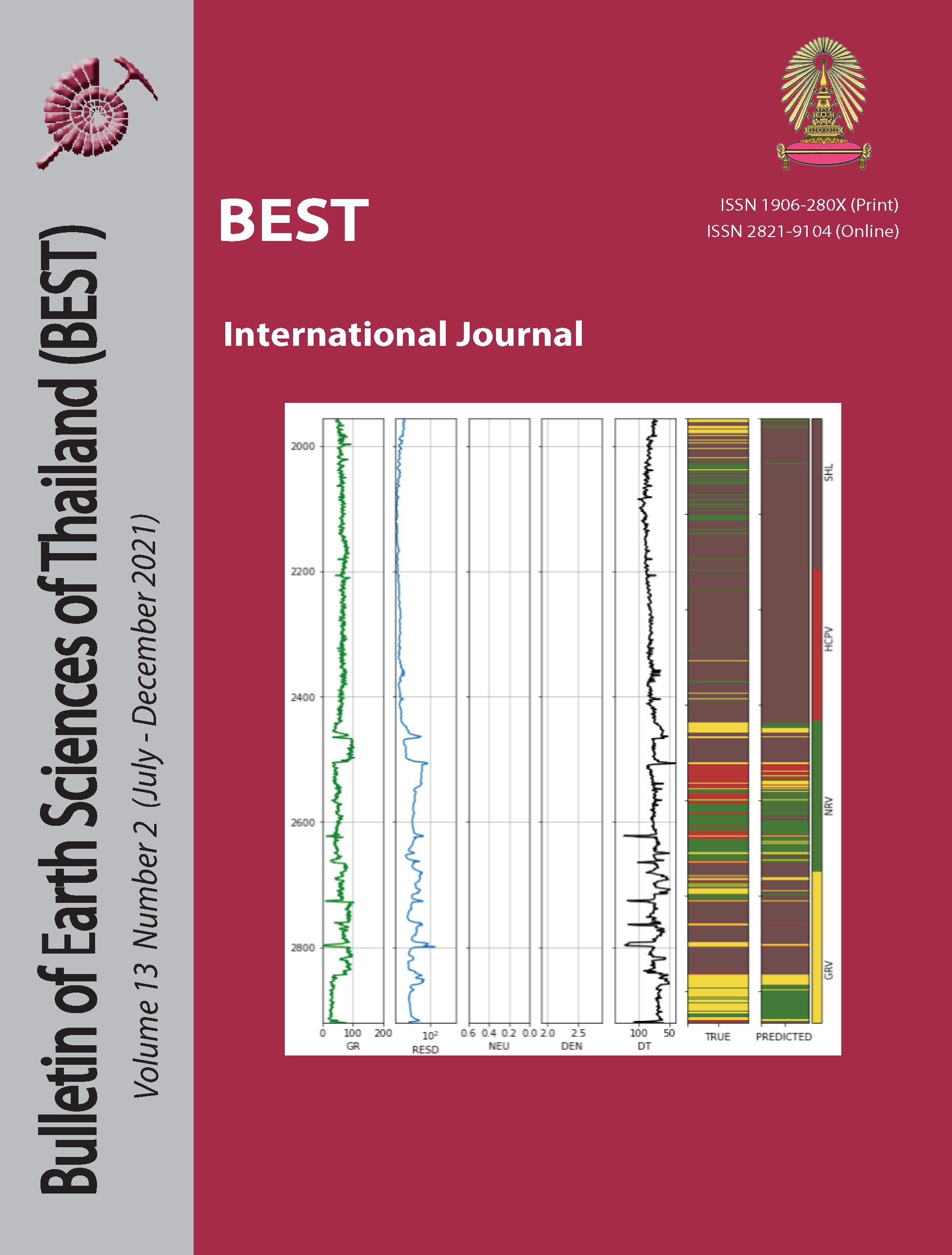Fibrous calcite characteristics and petroleum potential source rock of Permian carbonate, central Thailand
Main Article Content
Abstract
The outcrop samples of the Permian carbonate in Phetchabun, central Thailand have been studied to determine the characteristics and the occurrence of bedding-parallel calcite fibrous veins. Field occurrence, petrographic study, and geochemical investigations are conducted to interpret the formation mechanism of the veins and to assess petroleum potential in two Permian carbonate rock localities, including Khao Khwang and Nam Duk Formations. Total organic carbon (TOC) and extractable organic matter (EOM) analysis are performed in order to evaluate source rock potential of the samples and pyrolysis. The bedding-parallel fibrous calcite vein is divided into two forms, including beef veins and cone-in-cone structure. Both characters present adjacent parallel growing of fibrous calcite veins to host rock bedding and they are approximately perpendicular to the bedding based on petrography. As the total organic carbon (TOC), extractable organic matter (EOM), and pyrolysis analyses conclude that both the Khao Khwang and the Nam Duk Formations have a capacity to produce hydrocarbons which are mainly gas-types as a dry gas prone source rock.
Article Details

This work is licensed under a Creative Commons Attribution-NonCommercial-NoDerivatives 4.0 International License.
Copyright © 2008 Department of Geology, Faculty of Science, Chulalongkorn University. Parts of an article can be photocopied or reproduced without prior written permission from the author(s), but due acknowledgments should be stated or cited accordingly.
References
Basson, I., and Viola, G., 2004, Passive kimberlite intrusion into actively dilating dyke– fracture arrays: evidence from fibrous calcite veins and extensional fracture cleavage: Lithos, v. 76, p. 283–297.
Booth, J., and Sattayarak, N. 2011. Subsurface Carboniferous-Cretaceous geology of NE Thailand. In: Ridd, M.F, Barber, A.J. & Crow, M.J. (eds.), The Geology of Thailand, pp. 185-222. London: The Geological Society.
Chonglakmani, C. and Sattayarak, N., 1984. Geological map of Thailand on 1: 250,000 scale: sheet Changwat Phetchabun (NE47-16). Department of Mineral Resources, Bangkok.
Cobbold, P.R., Zanella, A., Rodrigues, N., Loseth., H., 2013. Bedding - parallel fibrous veins (beef and cone-in-cone): worldwide occurrence and possible significance in term of fluid overpressure, hydrocarbon generation and mineralization. Marine and Petroleum Geology, 43, 1-20.
Franks, P.C., 1969. Nature, origin, and significance of cone-in-cone structures in the Kiowa Formation (Early Cretaceous), north-central Kansas. Journal of Sedimentary Research, 39, 1483-1454.
Helmcke, D. and Lindenberg, H.-G. (1983) New data on the “Indosinian” orogeny from central Thailand. Geol. Rundschau, v. 72, pp. 317 - 328
Meng, Q., Hooker, J., and Cartwright, J. 2017a. Early over-pressuring in organic-rich shales during burial: evidence from fibrous calcite veins in the Lower Jurassic Shales-with-Beef Member in the Wessex Basin, UK. Journal of the Geological Society 174: 869–882.
Metcalfe, I. 2011. Tectonic framework and Phanerozoic evolution of Sundaland. Gondwana Research 19: 3-21.
Moore, L.V. 1985. Significance of EOM/TOC ratios in identifying possible migration fairways, NPRA, North Slope, Alaska. United States.
Peters, K.E., and Cassa, M.R. 1994. Applied Source Rock Geochemistry. In The Petroleum System From Source To Trap, pp. 93-120.
Racey, A. 2011. Petroleum geology. In Ridd, M.F., Barber, A.J., and Crow, M.J. (eds.), The Geology of Thailand, pp. 351-392. London: The Geological Society.
Tissot, B., and Welte, D. 1984. Petroleum formation and occurance: a new approach to oil and gas exploration. Springer.
Ueno, K., and Charoentitirat, T. 2011. Carboniferous In Ridd, M.F., Barber, A.J., and Crow, M.J. (eds.), The Geology of Thailand, pp. 71-136. London: The Geological Society.
Yu, H., Zhou, X.Q., Wang, J.G., Guo, C., Wei H.Y., Chen, D.Z., 2015 The origin of bedding-parallel fibrous calcite veins in the Lower Permian Chihsia Formation in western Hubei Province, South China. Science Bulletin.


